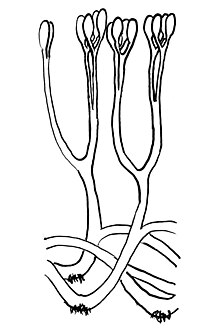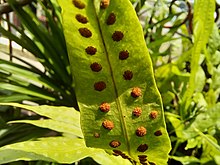
Back نباتات عديدة المباغات Arabic نباتات عديدة المباغات ARZ Çoxsporlu bitkilər Azerbaijani Polisporangiòfits Catalan Polysporangiophyta Spanish Polysporangiophyta Basque گیاهان چندهاگدانه Persian Polysporangiophyta Finnish Polysporangiophytes French Polysporangiophyta ID
| Polysporangiophyte Temporal range:
| |
|---|---|

| |
| Reconstruction of Aglaophyton, illustrating bifurcating axes with terminal sporangia, and rhizoids. | |

| |
| Modern polysporangiophyte, monarch fern is a vascular plant. | |
| Scientific classification | |
| Kingdom: | Plantae |
| Clade: | Embryophytes |
| Clade: | Polysporangiophytes Kenrick & Crane (1997) |
| Subgroups | |
| |
Polysporangiophytes, also called polysporangiates or formally Polysporangiophyta, are plants in which the spore-bearing generation (sporophyte) has branching stems (axes) that bear sporangia. The name literally means 'many sporangia plant'. The clade includes all land plants (embryophytes) except for the bryophytes (liverworts, mosses and hornworts) whose sporophytes are normally unbranched, even if a few exceptional cases occur.[1] While the definition is independent of the presence of vascular tissue, all living polysporangiophytes also have vascular tissue, i.e., are vascular plants or tracheophytes. Extinct polysporangiophytes are known that have no vascular tissue and so are not tracheophytes.
- ^ Harrison, C. Jill; Morris, Jennifer L. (2017). "The origin and early evolution of vascular plant shoots and leaves". Philosophical Transactions of the Royal Society B: Biological Sciences. 373 (1739): 20160496. doi:10.1098/rstb.2016.0496. PMC 5745332. PMID 29254961.